Enhancing Building Energy Management: Adaptive Edge Computing for Optimized Efficiency and Inhabitant Comfort †
Abstract
:1. Introduction
- The energy efficiency (EE) measures recommended by these ML and DL models solely consider energy-related variables. They are not focused on the inhabitants’ ability to adopt these solutions in their daily life, i.e., they do not consider the inhabitants’ comfort or the reputation of the recommended energy-saving measures among inhabitants.
- Generally, classical ML models, especially those based on DL, cannot be interpreted, impeding the recommendation of EE measures.
2. State of the Art
2.1. Edge Computing
2.2. Federated Learning
- The preservation of data privacy.
- It is hyper-personalized since it learns from each user’s inputs.
- It allows for low cloud infrastructure overheads as the model training, one of the operations with the highest computational cost, is carried out in a distributed manner on several external devices.
2.3. Virtual Organizations
2.4. Social Computing
2.5. Deep Learning
2.6. Research Gaps
3. Methodology
3.1. Functional Requirements
Data Sources
3.2. Non-Functional Requirements
3.2.1. Specifications of the 3-Tier Architecture
- Edge-building architecture emphasizes modularity, allowing components to be added or removed without disrupting the system’s flow. Maintenance should be seamless, enabling debugging and issue resolution without affecting other devices or functionalities. Adaptability is crucial for connecting to various devices and protocols, while reliability ensures resilience in the face of failures. Scalability is measured by the system’s capacity to handle devices and simultaneous calls. Security is paramount for communication protocols, and orchestration manages call priorities and synchronization. Communication should support both synchronous and asynchronous commands with robust recovery mechanisms. The network architecture must ensure reliable and timely device–edge communication. Lastly, seamless integration is vital for establishing connections with both known and unknown devices.
- On the other hand, the edge–cloud architecture also emphasizes modularity and maintenance, with a focus on communication protocols and acceptable latency. Reliability remains critical, and scalability pertains to the number of buildings supported. Security extends to edge–cloud communication, while storage architecture considers hot and cold storage needs.
- Data management is crucial for handling online and offline data, optimizing data flow between devices, edge, and cloud, integrating data from external sources, and managing data lifecycles based on usage patterns. Demand management with third-party API integration meets the requirements.
- Dashboards provide user and device management interfaces, enabling analytics insights and real-time monitoring. Mobile/web apps offer user interaction and preference management through APIs.
- Logging involves historical user preference logging, device failure tracking, and command logging for smart devices, while alerts notify of device connection failures and power threshold exceedances.
3.2.2. Hardware Requirements of the Edge
3.2.3. AI Requirements
3.2.4. Energy Efficiency Measures
4. Proposed Architecture
4.1. Layer Architecture
- IoT layer: The main characteristic of the components located in this layer is that they are deployed in the field. This layer is responsible for ingestion and communication at a low level, obtaining data from the different sources of information in the environment, mainly sensors. These make up the physical intake devices, which also belong to this layer. It is worth noting that the nodes in this layer are called “IoT nodes”, and that they are physical devices. Specifically, physical intake devices include sensors and sensor aggregation probes. Also in this category are the devices necessary for the communication of the IoT nodes with the edge node, such as a router, gateway, and another network device.
- Edge layer: This layer is the data management system for the data ingested from the IoT layer, and it is responsible for preprocessing the data and applying artificial intelligence analysis to them. This makes it possible to later send the data to the cloud layer to ensure data persistence. The edge layer is housed in one or several computing nodes, deployed in several buildings’ rooms, close to the physical devices for data ingestion (probes with a set of integrated sensors). It is important to remark that the nodes described within this layer are called “edge nodes”, and in this category are the nodes deployed in the field in charge of centralizing the data intake. They correspond to the edge layer and contain the functionality needed to ingest the data sent by the IoT nodes; they preprocess the data, analyze it (using federated learning), and send it for storage in the cloud nodes.
- Cloud layer: This layer houses the functionalities related to data persistence, coordination of artificial intelligence analysis, and management of content that can be viewed by the user. As its name indicates, this layer is in a cloud environment. It is worth noting that the nodes described within this layer are called “cloud nodes”. In this category, they are the nodes deployed in the cloud to perform the persistence, coordination of analysis, and visualization of the IoT data sent by the edge nodes.
4.2. Multi-Agent Architecture
- Virtual device organization: This can be composed of several replicated virtual organizations. Represented in blue, it can be formed by the following agents:
- -
- Edge ingestion agent: An agent in physical devices that is in charge of taking data and sending it to its associated virtual edge organization.
- Virtual edge organization: This can be composed of several replicated virtual organizations. Represented in green, it can be made up of the following agents:
- -
- Edge analysis agent: Performs simple analyses with a low computational load on its virtual edge organization.
- -
- Edge coordination agent: Coordinates communications and analysis in the virtual edge organization. It also coordinates data delivery to the virtual cloud organization.
- Virtual cloud organization: Represented in orange, it can be conformed by the following agents:
- -
- Communication coordination agent: Coordinates the communications in the virtual cloud organization.
- -
- Cloud ingestion agent: Coordinates the preprocessing of the data ingestion coming from the virtual edge organization, then sends the preprocessed data to the cloud persistence agent.
- -
- Cloud persistence agent: In charge of storage management in the virtual cloud organization.
- -
- Cloud analysis agent: In charge of the management of the analyses performed in the virtual cloud organization.
- -
- Cloud coordination agent: In charge of the coordination of tasks, events, and information flows triggered by the user (events coming from the view served by the cloud visualization agent) and the system (events created by this agent in a cyclic way to perform system tasks), within the cloud virtual organization.
- -
- Cloud visualization agent: Provides the user with a graphical interface to interact with the system.
4.3. User Roles
- Administrator user: This is the advanced user of the system, with access privileges to the data. It represents the person in charge of a building (community president, property manager, or authorized person). This user is able to view the data concerning all the dwellings in the building they manage and the results of the sensors installed in them, as well as the conclusions of the intelligent consumption optimization algorithms.
- Simple user: This is the simple user of the system. It represents the owners or tenants of a house. Owners keep their homes monitored in order to receive information on consumption and suggestions for optimization. A simple user can only access the data of their own home.
4.4. Analysis Architecture
- IoT physical nodes: Consists of sensor nodes (composed of data aggregation probes and physical sensors that perform physical measurements), responsible for collecting data from the environment. Subsequently, the nodes send said data periodically through the IoT wireless transmission system to the event management system.
- IoT wireless transmission system: A network system responsible for providing wide-area coverage to physical IoT nodes in order to communicate with the event management system. It should be noted that this system has several proposed technologies as the basis for its implementation, which is chosen on the basis of the types of sensors, gateways, and other available physical devices.
- Event management system: This is a component that works in the event-driven paradigm, collecting data from the producing subsystems and sending them to the consumer systems subscribed to it.
- Data analysis and federated learning subsystem: Receives all the data from the event management system and applies preprocessing and analysis to it at the edge. This analysis is part of the federated learning paradigm since it is the method that best adapts, in this case, to physical deployment. Subsequently, the subsystem sends the data and results to the cloud ecosystem to allow for their usage by the different cloud services.
- Artificial intelligence coordination service: This service is responsible for carrying out the heaviest statistical and artificial intelligence multiple analyses, which cannot be carried out in the edge environment. It is also responsible for coordinating the federated learning system, i.e., knowledge exchange between the edge nodes.
- Task management service: Carries out task management in the background.
- Ingest management service: Performs data ingestion and stores data in the persistence system.
- Notification alert service: Sends notifications to users and edge devices.
- Web application: Provides the user with a graphical interface which enables them to work with IoT data, analysis, etc. It is responsible for providing the functionality of the system to the user and allowing them to interact.
5. Use Case
- Heat pump–air conditioner:
- -
- Model: PKA-RP60KAL.
- -
- Brand: Mitsubishi Electric.
- Other pieces of equipment that have been used:
- -
- Data concentrator board based on Nvidia brand.
- -
- Communication modules: WiFi, Bluetooth, Zigbee, etc.
- -
- Sensors, controllers, and actuators of different types.
- -
- Equipment, development environments, software, servers, and infrastructure for the deployment of solutions both locally and in the cloud.
5.1. Hardware Components
5.2. Edge Computing Pilot Objectives
Goals
- General goals:
- -
- Benchmark of the different architecture designs: hybrid cloud–edge architecture options.
- -
- Validate connectivity between devices and edge computing devices: latency, frequency, protocols.
- -
- Validate the proper access to external public and private data sources and centralized resources.
- -
- Identify system vulnerabilities in terms of the security of customer data in outdoor systems and communications with the outside.
- -
- Identify data protection options.
- Data analytics goals:
- -
- Receive pre-trained data from cloud systems.
- -
- Data storage capacity on the edge device.
- -
- Data exchange between central systems and edge; data privacy.
- -
- Analyze the processing capacity at the edge for data and processes such as training and execution of machine learning processes.
- ∗
- The volume of data that can be processed.
- ∗
- The execution times in training/execution.
- ∗
- Limitations in terms of optimization models or algorithms.
- -
- Cost analysis of the solution in implementation and maintenance.
- -
- Benchmark architecture, cost, and functionality.
5.3. Architecture Implementation
- IoT wireless transmission system: Implemented through a WiFi network, which provides a large area of connectivity at the cost of reduced bandwidth, making it ideal for the use case that had been considered in this research. However, it may be necessary to use other technologies, such as LoRa, depending on the constraints of the physical environment of deployment and those of implementation.
- Event management system: A free software system that implements the MQTT protocol (two), designed and built specifically for multi-sensor data ingestion use cases in IoT environments. Specifically, the selected system is Eclipse Mosquitto, under the Eclipse license.
- Nvidia Jetson: This is the edge node implementation. It is proposed to use an Nvidia Jetson board to be able to carry out artificial intelligence analyses under the federated learning paradigm developed in Python. Among other advantages, this language allows for agile development, helping to adapt the data to the needs of the components that belong to the IoT and cloud layers, since this component is the interface between these two.
- Artificial intelligence coordination service: This consists of an API rest, which contains integrated heavy artificial intelligence models that cannot be carried out at the edge due to the computing demand they offer. It also holds the responsibility of coordinating the process of exchanging knowledge regarding federated learning between the edge nodes. Since these are developed in Python, this API is also to be developed in Python together with Flask, the most widely used framework for developing API rest in Python today.
- Task service, ingest service, and alert notification service: These are implemented in Python alongside Flask, the most widely used framework for API rest development in Python today, due to the flexibility they offer.
- Web application: A web application developed in JavaScript in the context of the MEVN stack. This component has two main sections: the backend, which is to be developed on the Node.js framework, and Express due to the use of the MEVN stack. In the case of the frontend, the Vue.js framework is to be developed due to the use of the MEVN stack.
- Databases: It has been decided to use PostgreSQL, because it is the most used SQL database today due to its extensibility, replication capacity, and agile development ability.
- A complete smart platform based on virtual organizations, designed as a three-tier architecture capable of ingesting data from multiple sources and providing tailored responses for an efficient energy consumption pattern.
- An IoT network and edge gateways capable of meeting the data ingestion requirements of the platform to be deployed in the pilot stage and of encrypting data at the hardware level.
- A data security and privacy protocol integrating cutting-edge cryptography solutions and a DLT-based approach.
- A social machine capable of managing the information processed by the platform, classifying, and monitoring the information, identifying different scenarios, and providing tailored responses (DSS).
- A new deep reinforcement learning approach (deep symbolic learning) using hybrid neuro-symbolic artificial intelligence algorithms for better integration of machine reasoning and learning capacities.
- New predictive and optimization models based on hybrid symbolic learning.
- Datasets gathered from the buildings involved in the demonstration phase, which enable the retrieval of information about consumption in buildings (anonymized/aggregated and fully compliant with all ethical and privacy recommendations/legal frameworks).
- Models (e.g., energy consumption, suggestions vs. pattern modification, energy demand) considering social and human behavioral aspects (data correlation).
6. Results and Discussion
7. Conclusions
Author Contributions
Funding
Acknowledgments
Conflicts of Interest
References
- United Nations (UN). Climate Change, Goal 13—United Nations Sustainable Development Goals. 2022. Available online: https://www.un.org/sustainabledevelopment/climate-change/ (accessed on 28 July 2023).
- United Nations Environment Programme (UNEP). 2022 Global Status Report for Buildings and Construction—UNEP. 2022. Available online: https://www.unep.org/resources/publication/2022-global-status-report-buildings-and-construction (accessed on 28 July 2023).
- International Energy Agency (IEA). Buildings—Energy System—IEA. 2022. Available online: https://www.iea.org/energy-system/buildings (accessed on 28 July 2023).
- Liu, Y.; Yang, C.; Jiang, L.; Xie, S.; Zhang, Y. Intelligent Edge Computing for IoT-Based Energy Management in Smart Cities. IEEE Netw. 2019, 33, 111–117. [Google Scholar] [CrossRef]
- Kamienski, C.A.; Borelli, F.F.; Biondi, G.O.; Pinheiro, I.; Zyrianoff, I.D.; Jentsch, M. Context Design and Tracking for IoT-Based Energy Management in Smart Cities. IEEE Internet Things J. 2018, 5, 687–695. [Google Scholar] [CrossRef]
- Ponlatha, S.; Umasankar, P.; Balashanmuga Vadivu, P.; Chitra, D. An IOT-based efficient energy management in smart grid using SMACA technique. Int. Trans. Electr. Energy Syst. 2021, 31, e12995. [Google Scholar] [CrossRef]
- Wei, M.; Hong, S.H.; Alam, M. An IoT-based energy-management platform for industrial facilities. Appl. Energy 2016, 164, 607–619. [Google Scholar] [CrossRef]
- Munisamy, V.; Gunasekaran, J. IoT Based Energy Management System (EMS) Using SOFAT Technique for Smart Grid Distribution System. Electr. Power Compon. Syst. 2022, 50, 282–300. [Google Scholar] [CrossRef]
- Singh, M.; Ahmed, S. IoT based smart water management systems: A systematic review. Mater. Today Proc. 2021, 46, 5211–5218. [Google Scholar] [CrossRef]
- Marques, P.; Manfroi, D.; Deitos, E.; Cegoni, J.; Castilhos, R.; Rochol, J.; Pignaton, E.; Kunst, R. An IoT-based smart cities infrastructure architecture applied to a waste management scenario. Ad Hoc Netw. 2019, 87, 200–208. [Google Scholar] [CrossRef]
- Seker, S. IoT based sustainable smart waste management system evaluation using MCDM model under interval-valued q-rung orthopair fuzzy environment. Technol. Soc. 2022, 71, 102100. [Google Scholar] [CrossRef]
- Ramalho, M.S.; Rossetti, R.J.; Cacho, N.; Souza, A. SmartGC: A software architecture for garbage collection in smart cities. Int. J. Bio-Inspired Comput. 2020, 16, 79. [Google Scholar] [CrossRef]
- Khalil, M.; McGough, A.S.; Pourmirza, Z.; Pazhoohesh, M.; Walker, S. Machine Learning, Deep Learning and Statistical Analysis for forecasting building energy consumption—A systematic review. Eng. Appl. Artif. Intell. 2022, 115, 105287. [Google Scholar] [CrossRef]
- Olu-Ajayi, R.; Alaka, H.; Sulaimon, I.; Sunmola, F.; Ajayi, S. Building energy consumption prediction for residential buildings using deep learning and other machine learning techniques. J. Build. Eng. 2022, 45, 103406. [Google Scholar] [CrossRef]
- Mocanu, E.; Nguyen, P.H.; Gibescu, M.; Kling, W.L. Deep learning for estimating building energy consumption. Sustain. Energy Grids Netw. 2016, 6, 91–99. [Google Scholar] [CrossRef]
- Anand, P.; Deb, C.; Yan, K.; Yang, J.; Cheong, D.; Sekhar, C. Occupancy-based energy consumption modelling using machine learning algorithms for institutional buildings. Energy Build. 2021, 252, 111478. [Google Scholar] [CrossRef]
- Zekić-Sušac, M.; Mitrović, S.; Has, A. Machine learning based system for managing energy efficiency of public sector as an approach towards smart cities. Int. J. Inf. Manag. 2021, 58, 102074. [Google Scholar] [CrossRef]
- Mir, U.; Abbasi, U.; Mir, T.; Kanwal, S.; Alamri, S. Energy Management in Smart Buildings and Homes: Current Approaches, a Hypothetical Solution, and Open Issues and Challenges. IEEE Access 2021, 9, 94132–94148. [Google Scholar] [CrossRef]
- Zhang, X.; Biagioni, D.; Cai, M.; Graf, P.; Rahman, S. An Edge-Cloud Integrated Solution for Buildings Demand Response Using Reinforcement Learning. IEEE Trans. Smart Grid 2021, 12, 420–431. [Google Scholar] [CrossRef]
- Sittón-Candanedo, I.; Alonso, R.S.; García, Ó.; Muñoz, L.; Rodríguez-González, S. Edge Computing, IoT and Social Computing in Smart Energy Scenarios. Sensors 2019, 19, 3353. [Google Scholar] [CrossRef]
- Ferrández-Pastor, F.J.; Mora, H.; Jimeno-Morenilla, A.; Volckaert, B. Deployment of IoT Edge and Fog Computing Technologies to Develop Smart Building Services. Sustainability 2018, 10, 3832. [Google Scholar] [CrossRef]
- Gourisetti, S.N.G.; Cali, Ü.; Choo, K.K.R.; Escobar, E.; Gorog, C.; Lee, A.; Lima, C.; Mylrea, M.; Pasetti, M.; Rahimi, F.; et al. Standardization of the Distributed Ledger Technology cybersecurity stack for power and energy applications. Sustain. Energy Grids Netw. 2021, 28, 100553. [Google Scholar] [CrossRef]
- Rahman, A.; Nasir, M.K.; Rahman, Z.; Mosavi, A.; S, S.; Minaei-Bidgoli, B. DistBlockBuilding: A Distributed Blockchain-Based SDN-IoT Network for Smart Building Management. IEEE Access 2020, 8, 140008–140018. [Google Scholar] [CrossRef]
- Lee, A.; Gourisetti, S.N.G.; Sebastian-Cardenas, D.J.; Lambert, K.; Navarro, V.; Pasetti, M.; Cali, Ü.; Isirova, K.; Reddi, R.; Nitu, P.; et al. Assessment of the Distributed Ledger Technology for Energy Sector Industrial and Operational Applications Using the MITRE ATT&CK® ICS Matrix. IEEE Access 2023, 11, 69854–69883. [Google Scholar] [CrossRef]
- Bellagarda, J.S.; Abu-Mahfouz, A.M. An Updated Survey on the Convergence of Distributed Ledger Technology and Artificial Intelligence: Current State, Major Challenges and Future Direction. IEEE Access 2022, 10, 50774–50793. [Google Scholar] [CrossRef]
- Caldarelli, G. Understanding the Blockchain Oracle Problem: A Call for Action. Information 2020, 11, 509. [Google Scholar] [CrossRef]
- Lo, S.K.; Xu, X.; Staples, M.; Yao, L. Reliability analysis for blockchain oracles. Comput. Electr. Eng. 2020, 83, 106582. [Google Scholar] [CrossRef]
- Building Energy Management Systems (BEMS) Market: Forecast (2029)—Maximize Market Research. 2023. Available online: https://www.maximizemarketresearch.com/market-report/global-building-energy-management-systems-bems-market/118857/ (accessed on 14 August 2023).
- Smart Building Market: Global Industry Analysis and Forecast 2023–2029—Maximize Market Research. 2023. Available online: https://www.maximizemarketresearch.com/market-report/global-smart-building-market/6809/ (accessed on 14 August 2023).
- Alsafery, W.; Rana, O.; Perera, C. Sensing within Smart Buildings: A Survey. ACM Comput. Surv. 2023, 55, 1–35. [Google Scholar] [CrossRef]
- Lobaccaro, G.; Carlucci, S.; Löfström, E. A Review of Systems and Technologies for Smart Homes and Smart Grids. Energies 2016, 9, 348. [Google Scholar] [CrossRef]
- Sovacool, B.K.; Furszyfer Del Rio, D.D. Smart home technologies in Europe: A critical review of concepts, benefits, risks and policies. Renew. Sustain. Energy Rev. 2020, 120, 109663. [Google Scholar] [CrossRef]
- Orejon-Sanchez, R.D.; Crespo-Garcia, D.; Andres-Diaz, J.R.; Gago-Calderon, A. Smart cities’ development in Spain: A comparison of technical and social indicators with reference to European cities. Sustain. Cities Soc. 2022, 81, 103828. [Google Scholar] [CrossRef]
- Department of Economic and Social Affairs of the United Nations. World Urbanization Prospects The 2018 Revision. 2018. Available online: https://population.un.org/wup (accessed on 22 August 2023).
- Ghayvat, H.; Mukhopadhyay, S.; Gui, X.; Suryadevara, N. WSN- and IOT-Based Smart Homes and Their Extension to Smart Buildings. Sensors 2015, 15, 10350–10379. [Google Scholar] [CrossRef]
- Shokri Gazafroudi, A.; Soares, J.; Fotouhi Ghazvini, M.A.; Pinto, T.; Vale, Z.; Corchado, J.M. Stochastic interval-based optimal offering model for residential energy management systems by household owners. Int. J. Electr. Power Energy Syst. 2019, 105, 201–219. [Google Scholar] [CrossRef]
- Moreno, M.; Úbeda, B.; Skarmeta, A.; Zamora, M. How can We Tackle Energy Efficiency in IoT BasedSmart Buildings? Sensors 2014, 14, 9582–9614. [Google Scholar] [CrossRef]
- García, Ó.; Alonso, R.; Prieto, J.; Corchado, J. Energy Efficiency in Public Buildings through Context-Aware Social Computing. Sensors 2017, 17, 826. [Google Scholar] [CrossRef]
- Minoli, D.; Sohraby, K.; Occhiogrosso, B. IoT Considerations, Requirements, and Architectures for Smart Buildings—Energy Optimization and Next-Generation Building Management Systems. IEEE Internet Things J. 2017, 4, 269–283. [Google Scholar] [CrossRef]
- Zhanlin, J.; Ganchev, I.; O’Droma, M. A Generic IoT Architecture for Smart Cities. In Proceedings of the 25th IET Irish Signals & Systems Conference 2014 and 2014 China-Ireland International Conference on Information and Communities Technologies (ISSC 2014/CIICT 2014), Limerick, Ireland, 26–27 June 2014; Institution of Engineering and Technology: Stevenage, UK, 2014; Volume 2014, pp. 196–199. [Google Scholar] [CrossRef]
- Casado-Vara, R.; Martin-del Rey, A.; Affes, S.; Prieto, J.; Corchado, J.M. IoT network slicing on virtual layers of homogeneous data for improved algorithm operation in smart buildings. Future Gener. Comput. Syst. 2020, 102, 965–977. [Google Scholar] [CrossRef]
- Metallidou, C.K.; Psannis, K.E.; Egyptiadou, E.A. Energy Efficiency in Smart Buildings: IoT Approaches. IEEE Access 2020, 8, 63679–63699. [Google Scholar] [CrossRef]
- Solis-Mora, V.S.; Gruezo-Valencia, D.F. La Inteligencia Artificial (IA) al servicio de la eficiencia energética en el Ecuador. Domino Las Cienc. 2022, 8, 600–621. [Google Scholar]
- Martínez, M.; Santana, E.; Beliz, N. Análisis de los paradigmas de inteligencia artificial, para un modelo inteligente de gestión de la energía eléctrica. Rev. Iniciación Científica 2017, 3, 77–84. [Google Scholar]
- Guerrero Sánchez, A.E. Optimización de la Operación de un Sistema HVAC para Ahorro Energético, Mediante Estrategias de Inteligencia Artificial. Ph.D. Thesis, Universidad Autónoma de Querétaro, Santiago de Querétaro, Mexico, 2020. [Google Scholar]
- Omoniwa, B.; Hussain, R.; Javed, M.A.; Bouk, S.H.; Malik, S.A. Fog/edge computing-based IoT (FECIoT): Architecture, applications, and research issues. IEEE Internet Things J. 2019, 6, 4118–4149. [Google Scholar] [CrossRef]
- Jia, M.; Komeily, A.; Wang, Y.; Srinivasan, R.S. Adopting Internet of Things for the development of smart buildings: A review of enabling technologies and applications. Autom. Constr. 2019, 101, 111–126. [Google Scholar] [CrossRef]
- Verma, A.; Prakash, S.; Srivastava, V.; Kumar, A.; Mukhopadhyay, S.C. Sensing, Controlling, and IoT Infrastructure in Smart Building: A Review. IEEE Sens. J. 2019, 19, 9036–9046. [Google Scholar] [CrossRef]
- Rahimi, M.; Songhorabadi, M.; Kashani, M.H. Fog-based smart homes: A systematic review. J. Netw. Comput. Appl. 2020, 153, 102531. [Google Scholar] [CrossRef]
- Cosovic, M.; Tsitsimelis, A.; Vukobratovic, D.; Matamoros, J.; Anton-Haro, C. 5G Mobile Cellular Networks: Enabling Distributed State Estimation for Smart Grids. IEEE Commun. Mag. 2017, 55, 62–69. [Google Scholar] [CrossRef]
- Okay, F.Y.; Ozdemir, S. A fog computing based smart grid model. In Proceedings of the 2016 International Symposium on Networks, Computers and Communications, ISNCC 2016, Hammamet, Tunisia, 11–13 May 2016. [Google Scholar] [CrossRef]
- Chouikhi, S.; Merghem-Boulahia, L.; Esseghir, M. A fog computing architecture for energy demand scheduling in smart grid. In Proceedings of the 2019 15th International Wireless Communications and Mobile Computing Conference, IWCMC 2019, Tangier, Morocco, 24–28 June 2019; pp. 1815–1821. [Google Scholar] [CrossRef]
- Zahoor, S.; Javaid, S.; Javaid, N.; Ashraf, M.; Ishmanov, F.; Afzal, M.K. Cloud–Fog–Based Smart Grid Model for Efficient Resource Management. Sustainability 2018, 10, 2079. [Google Scholar] [CrossRef]
- Sittón-Candanedo, I.; Alonso, R.S.; Corchado, J.M.; Rodríguez-González, S.; Casado-Vara, R. A review of edge computing reference architectures and a new global edge proposal. Future Gener. Comput. Syst. 2019, 99, 278–294. [Google Scholar] [CrossRef]
- Yang, Q.; Liu, Y.; Chen, T.; Tong, Y. Federated machine learning: Concept and applications. ACM Trans. Intell. Syst. Technol. 2019, 10, 1–19. [Google Scholar] [CrossRef]
- Konečný, J.; McMahan, H.B.; Ramage, D.; Richtárik, P. Federated Optimization: Distributed Machine Learning for On-Device Intelligence. arXiv 2016, arXiv:1610.02527, 1–38. [Google Scholar]
- Konečný, J.; McMahan, H.B.; Yu, F.X.; Richtárik, P.; Suresh, A.T.; Bacon, D. Federated Learning: Strategies for Improving Communication Efficiency. arXiv 2016, arXiv:1610.05492, 1–10. [Google Scholar] [CrossRef]
- McMahan, H.B.; Moore, E.; Ramage, D.; Hampson, S.; Arcas, B.A.y. Communication-Efficient Learning of Deep Networks from Decentralized Data. In Proceedings of the 20th International Conference on Artificial Intelligence and Statistics, AISTATS 2017, Fort Lauderdale, FL, USA, 20–22 April 2017; Volume 54. [Google Scholar] [CrossRef]
- Aledhari, M.; Razzak, R.; Parizi, R.M.; Saeed, F. Federated Learning: A Survey on Enabling Technologies, Protocols, and Applications. IEEE Access 2020, 8, 140699–140725. [Google Scholar] [CrossRef]
- Li, T.; Sahu, A.K.; Talwalkar, A.; Smith, V. Federated Learning: Challenges, Methods, and Future Directions. IEEE Signal Process. Mag. 2020, 37, 50–60. [Google Scholar] [CrossRef]
- Zhang, C.; Xie, Y.; Bai, H.; Yu, B.; Li, W.; Gao, Y. A survey on federated learning. Knowl.-Based Syst. 2021, 216, 106775. [Google Scholar] [CrossRef]
- Kairouz, P.; McMahan, H.B.; Avent, B.; Bellet, A.; Bennis, M.; Nitin Bhagoji, A.; Bonawitz, K.; Charles, Z.; Cormode, G.; Cummings, R.; et al. Advances and Open Problems in Federated Learning. Found. Trends® Mach. Learn. 2021, 14, 1–210. [Google Scholar] [CrossRef]
- Pillutla, K.; Kakade, S.M.; Harchaoui, Z. Robust Aggregation for Federated Learning. IEEE Trans. Signal Process. 2022, 70, 1142–1154. [Google Scholar] [CrossRef]
- Isaksson, M.; Listo Zec, E.; Cöster, R.; Gillblad, D.; Girdzijauskas, S. Adaptive Expert Models for Federated Learning. In Lecture Notes in Computer Science (Including Subseries Lecture Notes in Artificial Intelligence and Lecture Notes in Bioinformatics). In Proceedings of the 25th International Conference on Human-Computer Interaction, HCII 2023, Copenhagen, Denmark, 23–28 July 2023; Volume 13448 LNAI, pp. 1–16. [Google Scholar] [CrossRef]
- Garcia-Fornes, A.; Hübner, J.F.; Omicini, A.; Rodriguez-Aguilar, J.A.; Botti, V. Infrastructures and tools for multiagent systems for the new generation of distributed systems. Eng. Appl. Artif. Intell. 2011, 24, 1095–1097. [Google Scholar] [CrossRef]
- Oyenan, W.H.; DeLoach, S.A.; Singh, G. Exploiting Reusable Organizations to Reduce Complexity in Multiagent System Design. In Agent-Oriented Software Engineering X. Lecture Notes in Computer Science (Including Subseries Lecture Notes in Artificial Intelligence and Lecture Notes in Bioinformatics); Springer: Berlin/Heidelberg, Germany, 2011; Volume 6038 LNCS, pp. 3–17. [Google Scholar] [CrossRef]
- Artikis, A. Dynamic Protocols for Open Agent Systems. In Proceedings of the 8th International Conference on Autonomous Agents and Multiagent Systems, AAMAS, Budapest, Hungary, 10–15 May 2009; Decker, K.S., Sichman, J.S., Sierra, C., Castelfranchi, C., Eds.; AAMAS: New York, NY, USA, 2009; Volume 1, pp. 97–104. [Google Scholar]
- Carrascosa, C.; Giret, A.; Julian, V.; Rebollo, M.; Argente, E.; Botti, V. Service Oriented MAS: An open architecture. In Proceedings of the 8th International Conference on Autonomous Agents and Multiagent Systems, AAMAS, Budapest, Hungary, 10–15 May 2009; Decker, K.S., Sichman, J.S., Sierra, C., Castelfranchi, C., Eds.; AAMAS: New York, NY, USA, 2009; pp. 1291–1292. [Google Scholar]
- Fogués, R.L.; Alberola, J.M.; Such, J.M.; Espinosa, A.; Garcia-Fornes, A. Towards Dynamic Agent Interaction Support in Open Multiagent Systems. In 2010 Conference on Artificial Intelligence Research and Development; Alquézar, R., Moreno, A., Aguilar, J., Eds.; IOS Press—Frontiers in Artificial Intelligence and Applications: Amsterdam, The Netherlands, 2010; Volume 220, pp. 89–98. [Google Scholar] [CrossRef]
- Gazafroudi, A.S.; Prieto, J.; Corchado, J.M. Virtual Organization Structure for Agent-Based Local Electricity Trading. Energies 2019, 12, 1521. [Google Scholar] [CrossRef]
- Altin, N.; Eyimaya, S.E.; Nasiri, A. Multi-Agent-Based Controller for Microgrids: An Overview and Case Study. Energies 2023, 16, 2445. [Google Scholar] [CrossRef]
- Waddington, H.; White, H.; Snilstveit, B.; Hombrados, J.G.; Vojtkova, M.; Davies, P.; Bhavsar, A.; Eyers, J.; Koehlmoos, T.P.; Petticrew, M.; et al. Applications of Agent-Based Methods in Multi-Energy Systems—A Systematic Literature Review. Energies 2023, 16, 2456. [Google Scholar] [CrossRef]
- Nagadi, K.; Basingab, M. Developing an agent-based platform to monitor intelligent buildings. Eng. Res. Express 2022, 4, 025002. [Google Scholar] [CrossRef]
- Rodríguez, S.; De Paz, J.F.; Villarrubia, G.; Zato, C.; Bajo, J.; Corchado, J.M. Multi-Agent Information Fusion System to manage data from a WSN in a residential home. Inf. Fusion 2015, 23, 43–57. [Google Scholar] [CrossRef]
- Rodriguez, S.; Julián, V.; Bajo, J.; Carrascosa, C.; Botti, V.; Corchado, J. Agent-based virtual organization architecture. Eng. Appl. Artif. Intell. 2011, 24, 895–910. [Google Scholar] [CrossRef]
- Abras, S.; Ploix, S.; Pesty, S.; Jacomino, M. A Multi-agent Home Automation System for Power Management. In Informatics in Control Automation and Robotics; Springer: Berlin/Heidelberg, Germany, 2007; Volume 40, pp. 59–68. [Google Scholar] [CrossRef]
- Gazafroudi, A.S.; Pinto, T.; Prieto-Castrillo, F.; Corchado, J.M.; Abrishambaf, O.; Jozi, A.; Vale, Z. Energy flexibility assessment of a multi agent-based smart home energy system. In Proceedings of the 2017 IEEE 17th International Conference on Ubiquitous Wireless Broadband (ICUWB), Salamanca, Spain, 12–15 September 2017; Volume 2018-Janua, pp. 1–7. [Google Scholar] [CrossRef]
- Zhang, Y.; Zhang, P. Machine training and parameter settings with social emotional optimization algorithm for support vector machine. Pattern Recognit. Lett. 2015, 54, 36–42. [Google Scholar] [CrossRef]
- Shadbolt, N. Knowledge acquisition and the rise of social machines. Int. J. Hum.-Comput. Stud. 2013, 71, 200–205. [Google Scholar] [CrossRef]
- Linden, G.; Smith, B.; York, J. Amazon.com recommendations: Item-to-item collaborative filtering. IEEE Internet Comput. 2003, 7, 76–80. [Google Scholar] [CrossRef]
- Von Ahn, L.; Blum, M.; Hopper, N.J.; Langford, J. CAPTCHA: Using hard AI problems for security. In Proceedings of the Eurocrypt 2003, International Conference on the Theory and Applications of Cryptographic Techniques—Lecture Notes in Computer Science, Warsaw, Poland, 4–8 May 2003; Volume 2656, pp. 294–311. [Google Scholar] [CrossRef]
- von Ahn, L.; Blum, M.; Langford, J. Telling humans and computers apart automatically. Commun. ACM 2004, 47, 56–60. [Google Scholar] [CrossRef]
- Qiu, L.; Rui, H.; Whinston, A.B. A Twitter-Based Prediction Market: Social Network Approach. In Proceedings of the International Conference on Information Systems 2011 (ICIS 2011), Shanghai, China, 4–7 December 2011; Volume 1, pp. 769–784. [Google Scholar] [CrossRef]
- Agha-Hossein, M.M.; Tetlow, R.M.; Hadi, M.; El-Jouzi, S.; Elmualim, A.A.; Ellis, J.; Williams, M. Providing persuasive feedback through interactive posters to motivate energy-saving behaviours. Intell. Build. Int. 2014, 7, 16–35. [Google Scholar] [CrossRef]
- Prensky, M. Digital game-based learning. Comput. Entertain. (CIE) 2003, 1, 1–4. [Google Scholar] [CrossRef]
- Katsaliaki, K.; Mustafee, N. Serious Games for Sustainable Development. J. Manag. Educ. 2013, 37, 889–894. [Google Scholar] [CrossRef]
- García, Ó.; Prieto, J.; Alonso, R.S.; Corchado, J.M. A Framework to Improve Energy Efficient Behaviour at Home through Activity and Context Monitoring. Sensors 2017, 17, 1749. [Google Scholar] [CrossRef]
- Castellanos-Garzón, J.A.; Costa, E.; Jaimes, S.J.L.; Corchado, J.M. An evolutionary framework for machine learning applied to medical data. Knowl.-Based Syst. 2019, 185, 104982. [Google Scholar] [CrossRef]
- Liu, W.; Wang, Z.; Liu, X.; Zeng, N.; Liu, Y.; Alsaadi, F.E. A survey of deep neural network architectures and their applications. Neurocomputing 2017, 234, 11–26. [Google Scholar] [CrossRef]
- Hernández-Nieves, E.; Hernández, G.; Gil-González, A.B.; Rodríguez-González, S.; Corchado, J.M. Fog computing architecture for personalized recommendation of banking products. Expert Syst. Appl. 2020, 140, 112900. [Google Scholar] [CrossRef]
- Khan, A.M.; Umar, I.; Ha, P.H. Efficient compute at the edge: Optimizing energy aware data structures for emerging edge hardware. In Proceedings of the Proceedings—2018 International Conference on High Performance Computing and Simulation, HPCS 2018, Orleans, France, 16–20 July 2018; pp. 314–321. [Google Scholar] [CrossRef]
- Montavon, G.; Samek, W.; Müller, K.R. Methods for interpreting and understanding deep neural networks. Digit. Signal Process. 2018, 73, 1–15. [Google Scholar] [CrossRef]
- Lecun, Y.; Bengio, Y.; Hinton, G. Deep learning. Nature 2015, 521, 436–444. [Google Scholar] [CrossRef] [PubMed]
- Remli, M.A.; Mohamad, M.S.; Deris, S.; A Samah, A.; Omatu, S.; Corchado, J.M. Cooperative enhanced scatter search with opposition-based learning schemes for parameter estimation in high dimensional kinetic models of biological systems. Expert Syst. Appl. 2019, 116, 131–146. [Google Scholar] [CrossRef]
- López-Sánchez, D.; González Arrieta, A.; Corchado, J.M. Compact bilinear pooling via kernelized random projection for fine-grained image categorization on low computational power devices. Neurocomputing 2020, 398, 411–421. [Google Scholar] [CrossRef]
- Chen, X.; Duan, Y.; Houthooft, R.; Schulman, J.; Sutskever, I.; Abbeel, P. InfoGAN: Interpretable Representation Learning by Information Maximizing Generative Adversarial Nets. Adv. Neural Inf. Process. Syst. 2016, 29, 2180–2188. [Google Scholar]
- Yao, S.; Hu, S.; Zhao, Y.; Zhang, A.; Abdelzaher, T. DeepSense: A Unified Deep Learning Framework for Time-Series Mobile Sensing Data Processing. In Proceedings of the 26th International World Wide Web Conference, WWW 2017, Perth, Australia, 3–7 April 2017; pp. 351–360. [Google Scholar] [CrossRef]
- Greff, K.; Srivastava, R.K.; Koutnik, J.; Steunebrink, B.R.; Schmidhuber, J. LSTM: A Search Space Odyssey. IEEE Trans. Neural Netw. Learn. Syst. 2017, 28, 2222–2232. [Google Scholar] [CrossRef]
- Goodfellow, I.; Bengio, Y.; Courville, A. Deep Learning; MIT Press: Cambridge, MA, USA, 2016. [Google Scholar]
- Bashir, I.; Koul, A. Face Recognition and Detection through Similarity Measurements. Int. J. Comput. Appl. 2017, 174, 38–48. [Google Scholar] [CrossRef]
- Litjens, G.; Kooi, T.; Bejnordi, B.E.; Setio, A.A.A.; Ciompi, F.; Ghafoorian, M.; van der Laak, J.A.; van Ginneken, B.; Sánchez, C.I. A survey on deep learning in medical image analysis. Med. Image Anal. 2017, 42, 60–88. [Google Scholar] [CrossRef]
- Young, T.; Hazarika, D.; Poria, S.; Cambria, E. Recent trends in deep learning based natural language processing [Review Article]. IEEE Comput. Intell. Mag. 2018, 13, 55–75. [Google Scholar] [CrossRef]
- López-Sánchez, D.; Arrieta, A.G.; Corchado, J.M. Visual content-based web page categorization with deep transfer learning and metric learning. Neurocomputing 2019, 338, 418–431. [Google Scholar] [CrossRef]
- Sutton, R.S.; Barto, A.G. Reinforcement Learning. An Introduction, 2nd ed.; The MIT Press: Cambridge, MA, USA, 2018; p. 548. [Google Scholar]
- Rodriguez-Fernandez, J.; Pinto, T.; Silva, F.; Praça, I.; Vale, Z.; Corchado, J.M. Context aware Q-Learning-based model for decision support in the negotiation of energy contracts. Int. J. Electr. Power Energy Syst. 2019, 104, 489–501. [Google Scholar] [CrossRef]
- Pinto, T.; Morais, H.; Corchado, J.M. Adaptive entropy-based learning with dynamic artificial neural network. Neurocomputing 2019, 338, 432–440. [Google Scholar] [CrossRef]
- Gazafroudi, A.S.; Prieto-Castrillo, F.; Pinto, T.; Prieto, J.; Corchado, J.M.; Bajo, J. Energy Flexibility Management Based on Predictive Dispatch Model of Domestic Energy Management System. Energies 2017, 10, 1397. [Google Scholar] [CrossRef]
- Guzek, M.; Bouvry, P.; Talbi, E.G. A survey of evolutionary computation for resource management of processing in cloud computing [review article]. IEEE Comput. Intell. Mag. 2015, 10, 53–67. [Google Scholar] [CrossRef]
- Pinto, R.; Goncalves, J.; Cardoso, H.L.; Oliveira, E.; Goncalves, G.; Carvalho, B. A Facility Layout Planner tool based on Genetic Algorithms. In Proceedings of the 2016 IEEE Symposium Series on Computational Intelligence, SSCI 2016, Athens, Greece, 6–9 December 2016. [Google Scholar] [CrossRef]
- Arrigoni, S.; Trabalzini, E.; Bersani, M.; Braghin, F.; Cheli, F. Non-linear MPC motion planner for autonomous vehicles based on accelerated particle swarm optimization algorithm. In Proceedings of the 2019 AEIT International Conference of Electrical and Electronic Technologies for Automotive, AEIT AUTOMOTIVE 2019, Turin, Italy, 2–4 July 2019. [Google Scholar] [CrossRef]
- Guo, Q.; Tang, L. Modelling and discrete differential evolution algorithm for order rescheduling problem in steel industry. Comput. Ind. Eng. 2019, 130, 586–596. [Google Scholar] [CrossRef]
- Huang, P.C.; Sentis, L.; Lehman, J.; Fok, C.L.; Mok, A.K.; Miikkulainen, R. Tradeoffs in Neuroevolutionary Learning-Based Real-Time Robotic Task Design in the Imprecise Computation Framework. ACM Trans. Cyber-Phys. Syst. 2018, 3, 14. [Google Scholar] [CrossRef]
- Nies, H.W.; Zakaria, Z.; Mohamad, M.S.; Chan, W.H.; Zaki, N.; Sinnott, R.O.; Napis, S.; Chamoso, P.; Omatu, S.; Corchado, J.M. A Review of Computational Methods for Clustering Genes with Similar Biological Functions. Processes 2019, 7, 550. [Google Scholar] [CrossRef]
- François-Lavet, V.; Henderson, P.; Islam, R.; Bellemare, M.G.; Pineau, J. An Introduction to Deep Reinforcement Learning. Found. Trends® Mach. Learn. 2018, 11, 219–354. [Google Scholar] [CrossRef]
- Yu, L.; Qin, S.; Zhang, M.; Shen, C.; Jiang, T.; Guan, X. A Review of Deep Reinforcement Learning for Smart Building Energy Management. IEEE Internet Things J. 2021, 8, 12046–12063. [Google Scholar] [CrossRef]
- Shaqour, A.; Hagishima, A. Systematic Review on Deep Reinforcement Learning-Based Energy Management for Different Building Types. Energies 2022, 15, 8663. [Google Scholar] [CrossRef]
- Gupta, A.; Badr, Y.; Negahban, A.; Qiu, R.G. Energy-efficient heating control for smart buildings with deep reinforcement learning. J. Build. Eng. 2021, 34, 101739. [Google Scholar] [CrossRef]
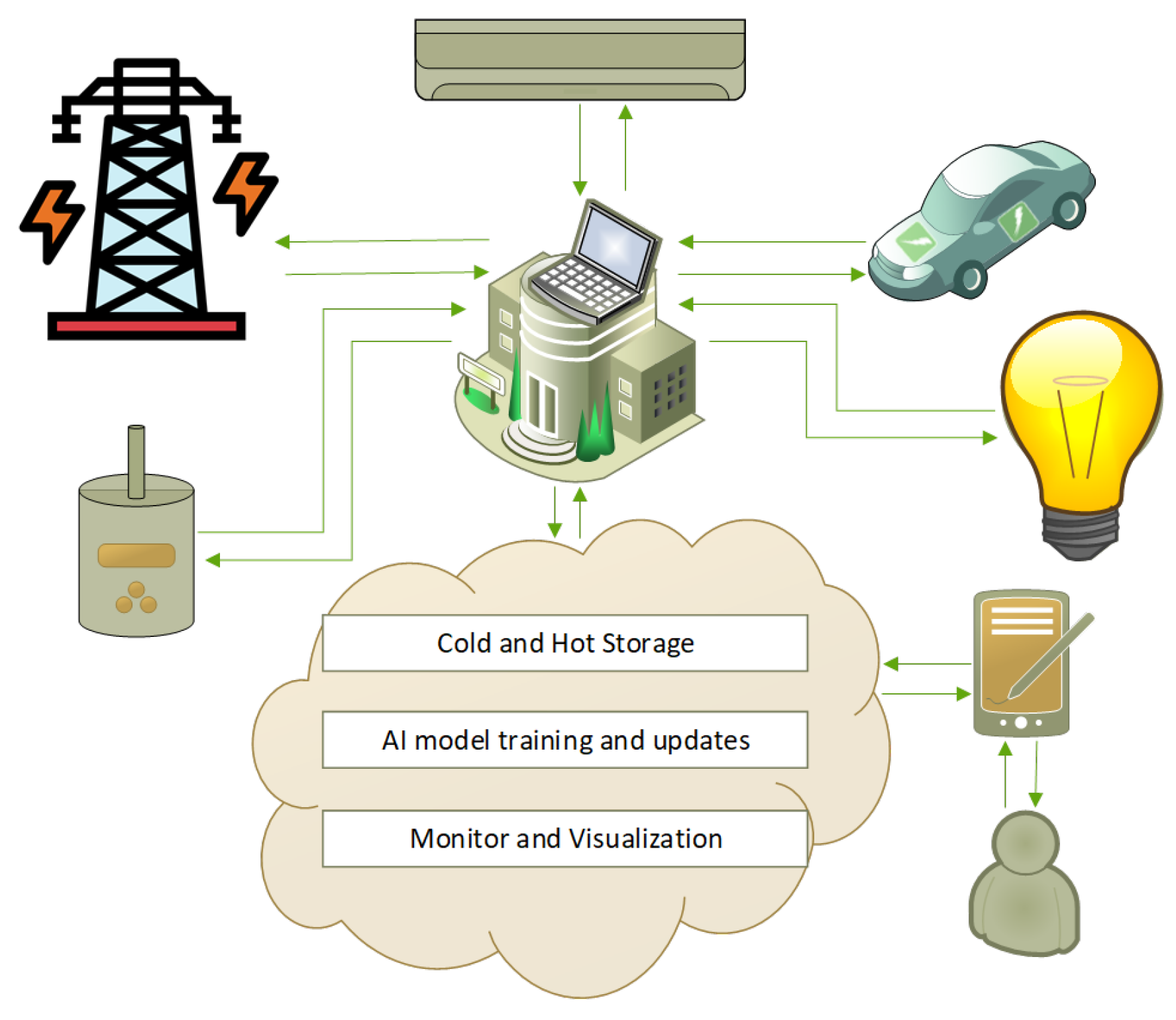
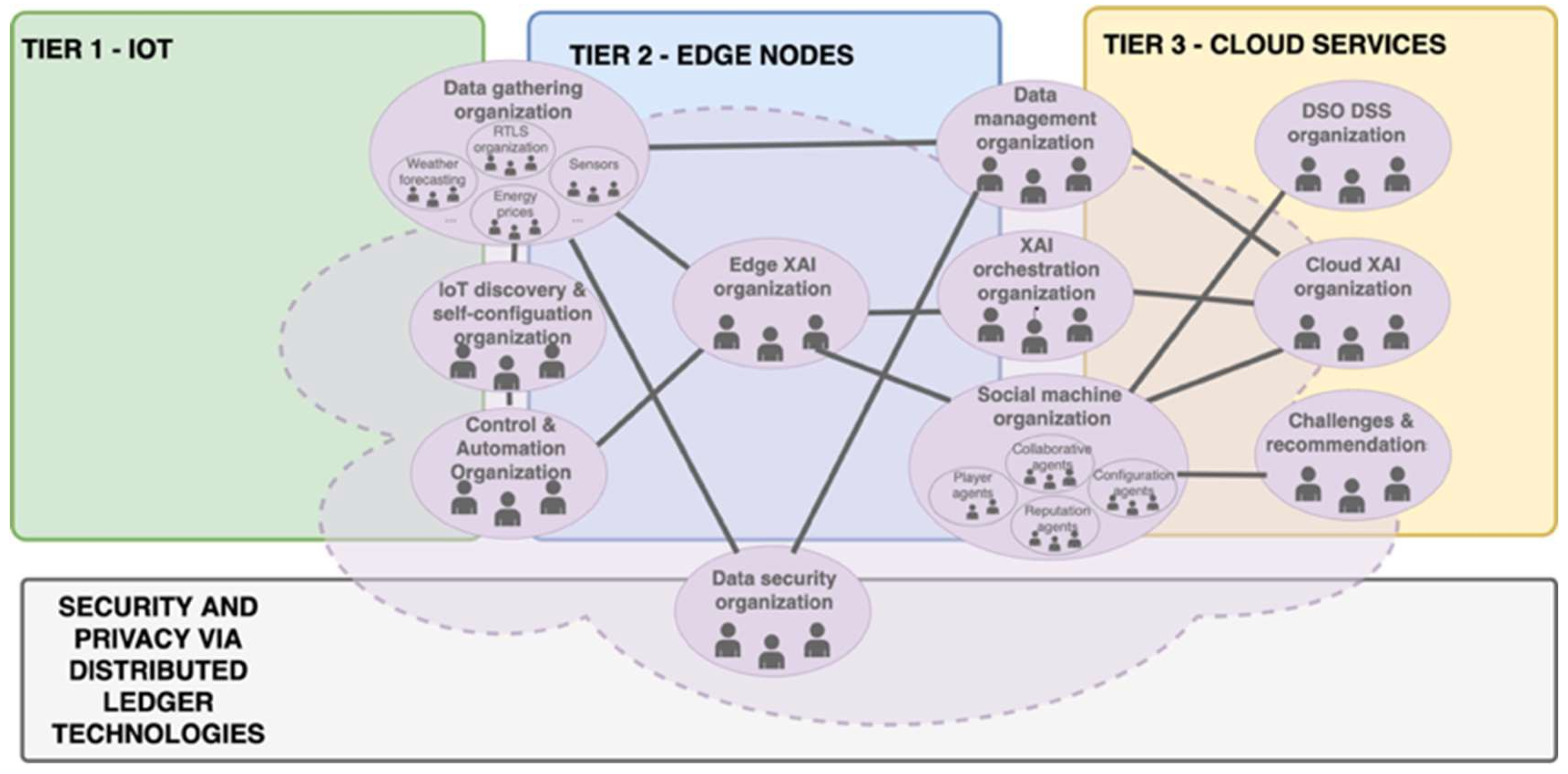

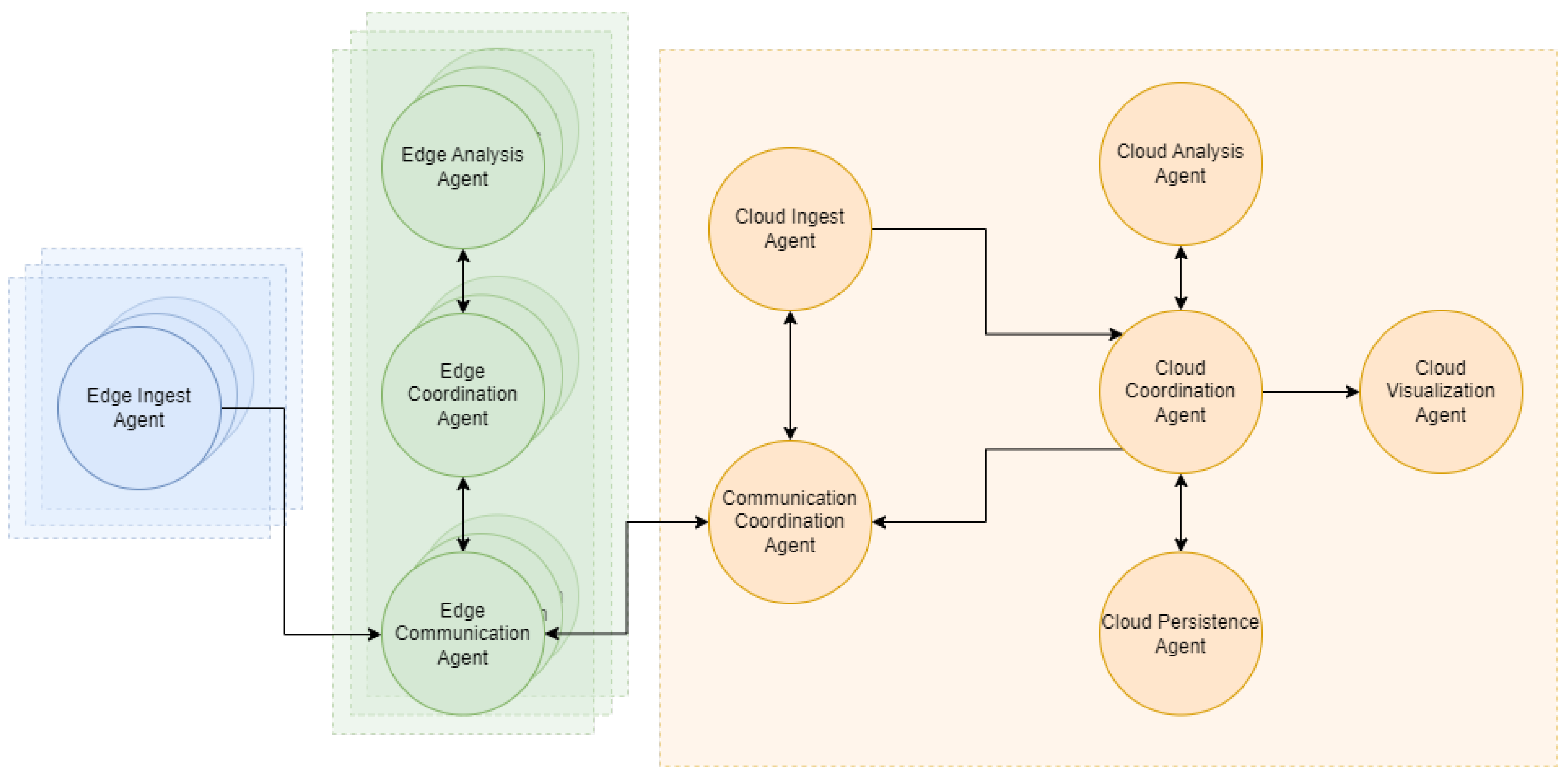

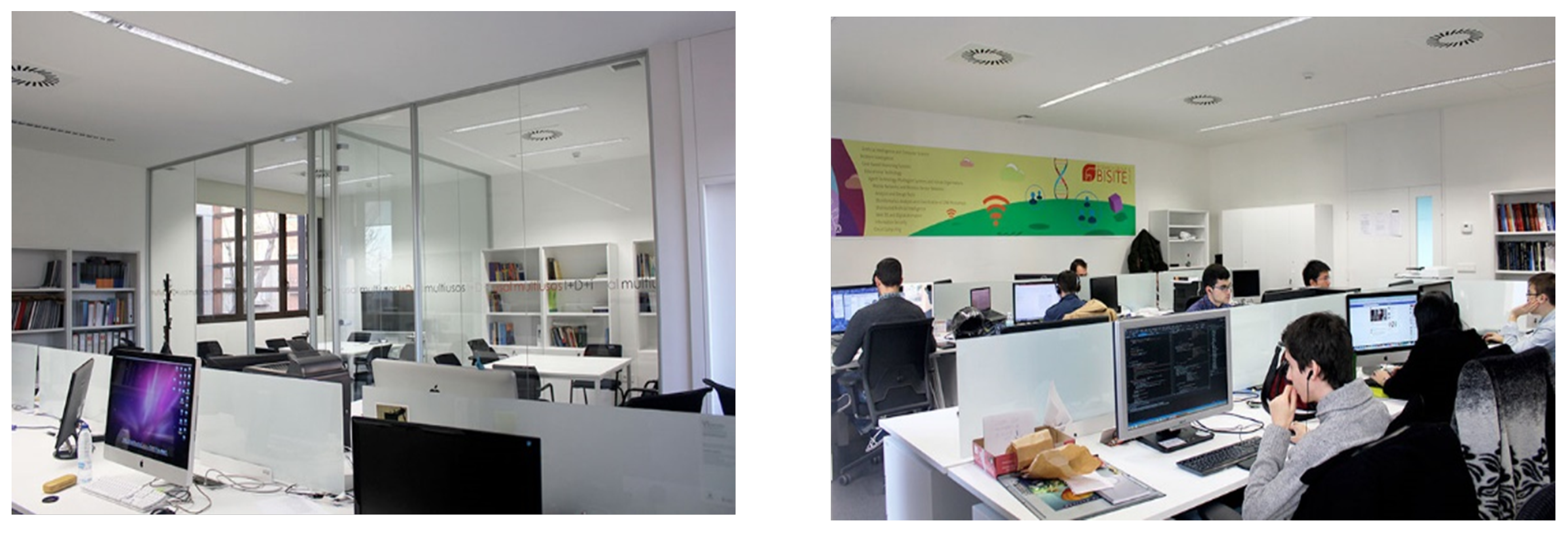
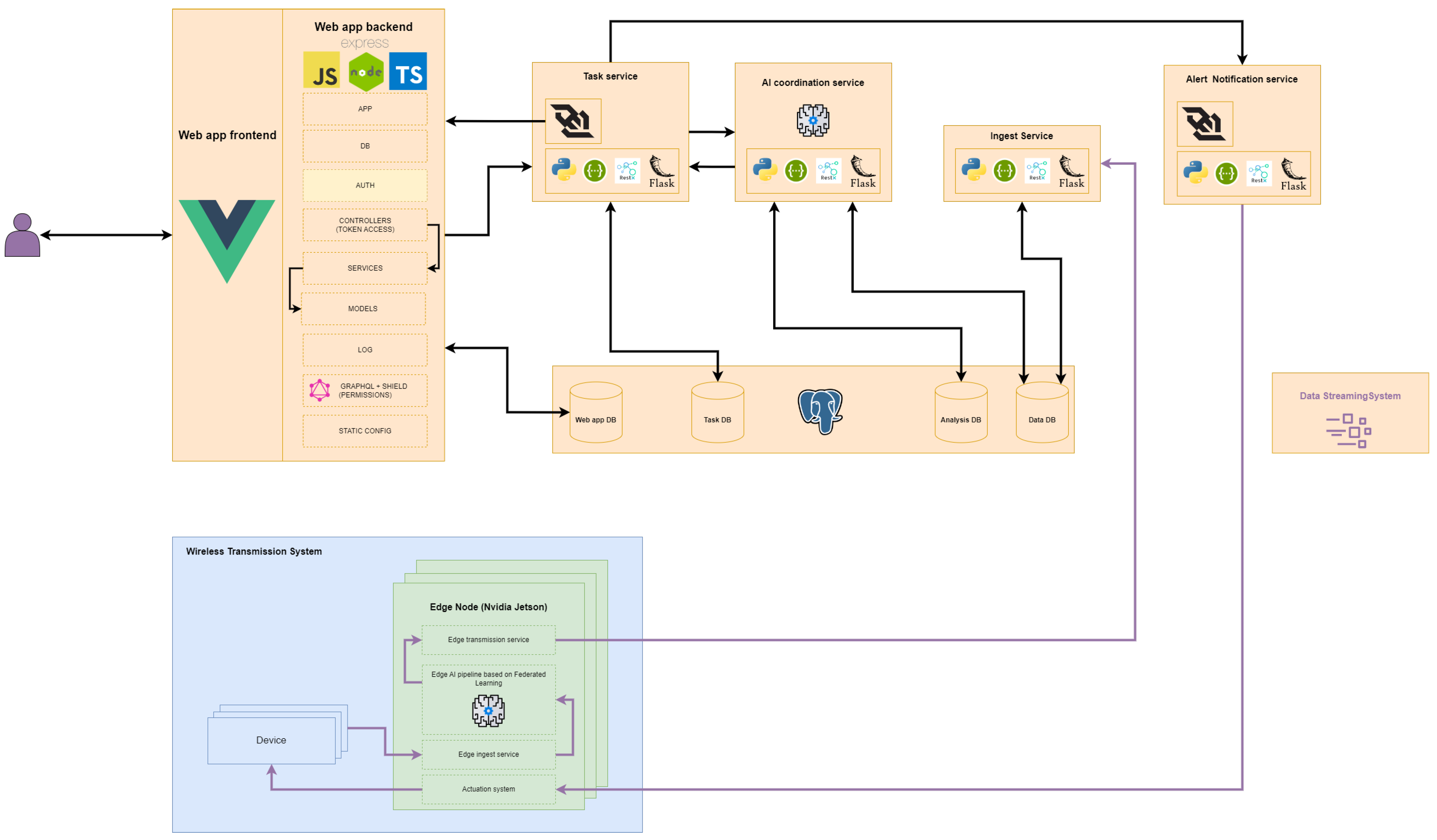


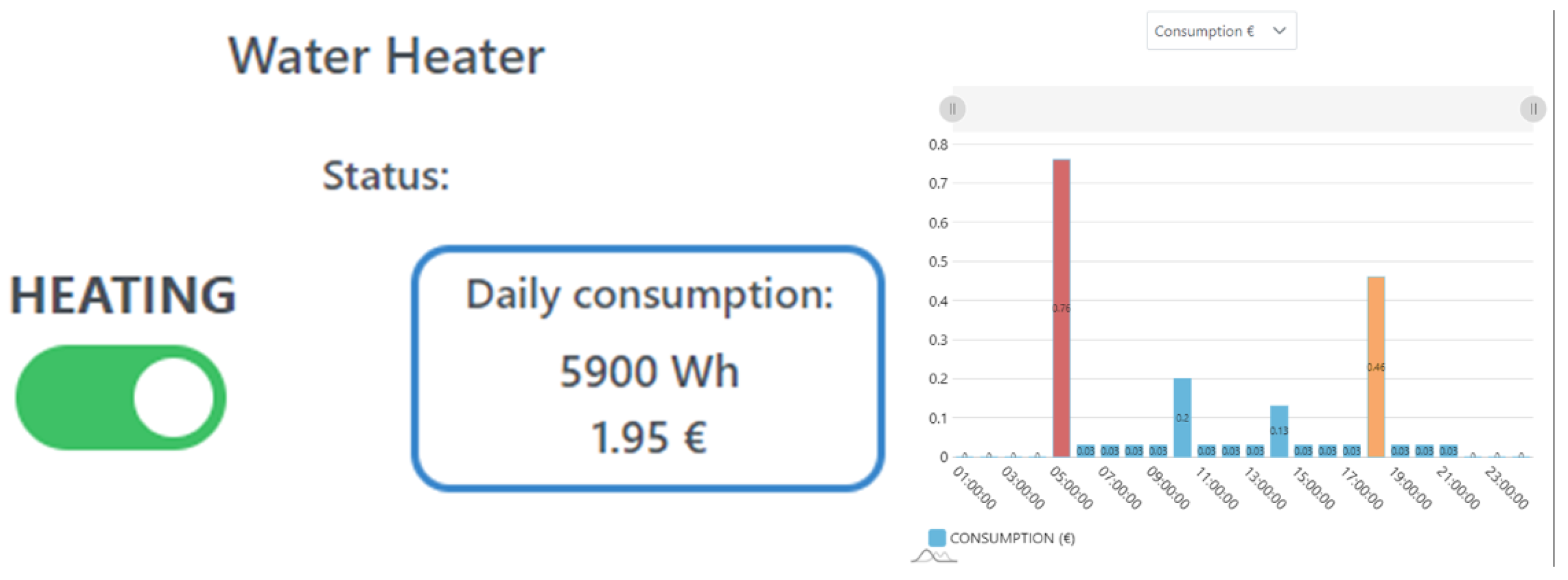
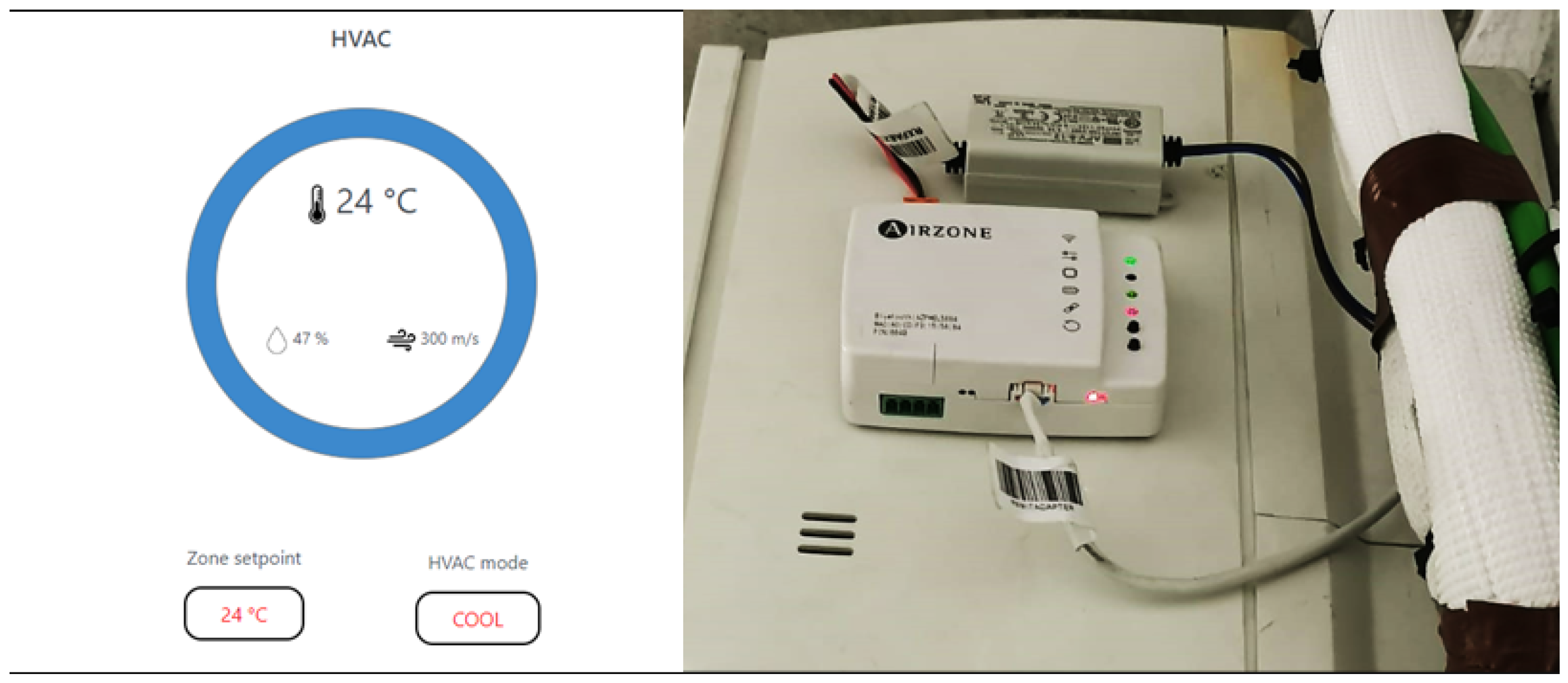

| Name of the Variable | Type of Variable | Possible Values | Example | Static | Source |
|---|---|---|---|---|---|
| VACATION MODE | Boolean | True/False | Off | No | User comfort preferences setup |
| Thermal Range (°C) | array | Array between 16 and 32 | 22,23,24,25,26,27 | No | User comfort preferences setup |
| Exported Energy (Wh) | int | Integer between 0 and 99,999 | 1609 | No | Smart meter |
| Generated Energy (Wh) | int | Integer between 0 and 99,999 | 234 | No | Smart meter |
| Purchased Energy (Wh) | int | Integer between 0 and 99,999 | 2345 | No | Smart meter |
| Self Consumption (Wh) | int | Integer between 0 and 99,999 | 2342 | No | Smart meter |
| Total Consumption (Wh) | int | Integer between 0 and 99,999 | 6235 | No | Smart meter |
| Voltage (V) | int | Integer between 0 and 99,999 | 230 | No | Smart meter |
| Current (A) | int | Integer between 0 and 99,999 | 10 | No | Smart meter |
| Reactive Energy (VARh) | int | Integer between 0 and 99,999 | 2345 | No | Smart meter |
| Battery Status (%) | int | Integer between 0 and 100 | 80 | No | EV |
| Charging Rate (A) | int | Integer between 0 and 32 | 23 | No | EV |
| Session Status | String | 8 character string | Charging | No | EV |
| Max Available Power (kW) | int | Integer between 6 and 99 | 32 | Yes | EV |
| End Session Time | float | date-time | 44,804.58333 | No | EV |
| Water Heater Status | String | 8 character string | Heating | No | Water heater |
| Water Heater Consumption (Wh) | int | Integer between 0 and 99,999 | 2300 | No | Water heater |
| Zone Temperature (°C) | int | Integer between 0 and 99 | 25 | No | HVAC |
| Zone Humidity (%) | int | Integer between 0 and 100 | 45 | No | HVAC |
| Fan Speed (m/s) | int | Integer between 0 and 99,999 | 300 | No | HVAC |
| HVAC Mode | String | 10 character string | Cool | No | HVAC |
| Zone Setpoint (°C) | int | Integer between 0 and 99 | 22 | No | HVAC |
| Component | Product | Description |
|---|---|---|
| Edge Device | Jetson Nano (Nvidia) | A compact, potent, and powerful kit designed to run powerful AI and machine learning algorithms with minimal power consumption. |
| Smart Meter | Wibeee Box (Wibeee) | A smart energy monitoring device with many features enabling wireless communication with the edge device. It also supports standalone operations via the manufacturer API. |
| HVAC | Aidoo Pro (Airzone) | An innovative smart thermostat that enables the control of a wide variety of HVAC systems, including the split units and centralized systems. |
| EV | EO Charging/EO Hub (EO) | A smart EV charger that has multiple features allowing for the efficient control of the charging sessions. |
| Plug Loads | Aeotec Smart Switch (Aeotec) | A smart plug that allows the control automation of significant plug loads. Also facilitates the control of the standard water heaters. |
| Cloud Platform | AWS (Amazon) | The cloud provider that hosts the cloud side of the solution. |
Disclaimer/Publisher’s Note: The statements, opinions and data contained in all publications are solely those of the individual author(s) and contributor(s) and not of MDPI and/or the editor(s). MDPI and/or the editor(s) disclaim responsibility for any injury to people or property resulting from any ideas, methods, instructions or products referred to in the content. |
© 2023 by the authors. Licensee MDPI, Basel, Switzerland. This article is an open access article distributed under the terms and conditions of the Creative Commons Attribution (CC BY) license (https://creativecommons.org/licenses/by/4.0/).
Share and Cite
Márquez-Sánchez, S.; Calvo-Gallego, J.; Erbad, A.; Ibrar, M.; Hernandez Fernandez, J.; Houchati, M.; Corchado, J.M. Enhancing Building Energy Management: Adaptive Edge Computing for Optimized Efficiency and Inhabitant Comfort. Electronics 2023, 12, 4179. https://doi.org/10.3390/electronics12194179
Márquez-Sánchez S, Calvo-Gallego J, Erbad A, Ibrar M, Hernandez Fernandez J, Houchati M, Corchado JM. Enhancing Building Energy Management: Adaptive Edge Computing for Optimized Efficiency and Inhabitant Comfort. Electronics. 2023; 12(19):4179. https://doi.org/10.3390/electronics12194179
Chicago/Turabian StyleMárquez-Sánchez, Sergio, Jaime Calvo-Gallego, Aiman Erbad, Muhammad Ibrar, Javier Hernandez Fernandez, Mahdi Houchati, and Juan Manuel Corchado. 2023. "Enhancing Building Energy Management: Adaptive Edge Computing for Optimized Efficiency and Inhabitant Comfort" Electronics 12, no. 19: 4179. https://doi.org/10.3390/electronics12194179
APA StyleMárquez-Sánchez, S., Calvo-Gallego, J., Erbad, A., Ibrar, M., Hernandez Fernandez, J., Houchati, M., & Corchado, J. M. (2023). Enhancing Building Energy Management: Adaptive Edge Computing for Optimized Efficiency and Inhabitant Comfort. Electronics, 12(19), 4179. https://doi.org/10.3390/electronics12194179







